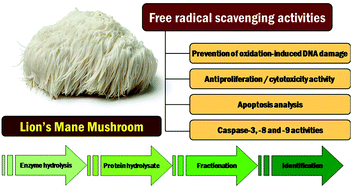Peptides obtained from edible mushrooms: Hericium erinaceus offers the ability to scavenge free radicals and induce apoptosis in lung cancer cells in humans
Abstract
This research examined the antioxidant abilities of peptides derived from the Hericium erinaceus mushroom produced via three microbial proteases (Alcalase®, Neutrase®, and Flavourzyme®) at varying concentrations of 10, 25, and 50 mg mL−1. The H. erinaceus mushroom hydrolysate produced from 10 mg mL−1 Alcalase® with 4 hours’ digestion resulted in the highest levels of 2,2′-azino-bis-3-ethylbenzthiazoline-6-sulphonic acid (ABTS), 2,2-diphenyl-1-picrylhydrazl (DPPH), and nitric oxide (NO) radical scavenging activities. Fractionation of this particular hydrolysate was then performed by ultrafiltration (10, 5, 3, and 0.65 kDa molecular weight cut-off membranes). The MW < 0.65 kDa fraction demonstrated the highest level of radical scavenging activity in the context of ABTS, DPPH, and NO. Therefore, the fraction MW < 0.65 kDa was performed with RP-HPLC to obtain the four principal fractions termed F1–4. The results reveal that the F4 sub-fraction demonstrated the best radical scavenging ability. Additionally, the F4 sub-fraction was able to reduce the potential for DNA damage caused by hydroxyl radicals. This was revealed by testing using the Fenton reaction and the pUC19, pKS, and pBR322 plasmids. This outcome was demonstrated through in vitro antiproliferative activity in human lung carcinoma cell lines (Chago-K1) using MTT assay. The F4 sub-fraction was also demonstrated to induce apoptosis, as indicated using the FITC Annexin V apoptosis detection kit with PI. Furthermore, it was also found that the activity of caspase-3, -8, and -9 in Chago-K1 cells was enhanced after exposure periods of 24 and 48 hours. Finally, this sub-fraction was selected for peptide sequencing via quadrupole-time-of-flight-electron spin induction-mass spectrometry-based de novo peptide sequencing.

- This article is part of the themed collection: Food & Function Recent HOT articles


 Please wait while we load your content...
Please wait while we load your content...